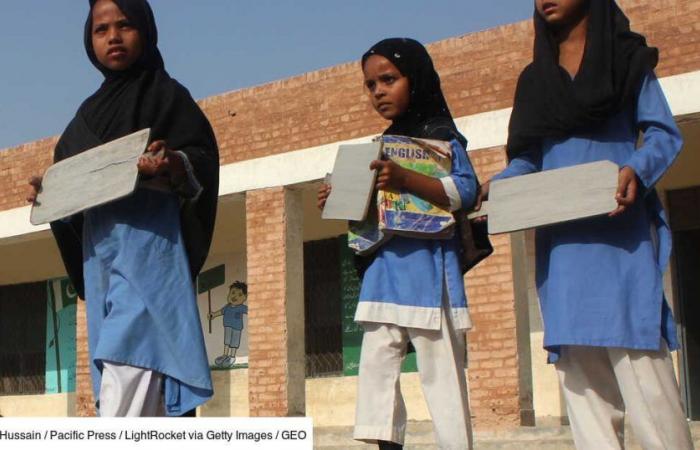With the monsoon that threatened the crops looming, Shamila and Amina, 14 and 13 years old, got married. A solution chosen by dozens of families in southern Pakistan, increasingly affected by climate change.
“I was happy when I was told I was going to get married”Shamila Ali tells AFP in her village of Khan Mohammad Mallah, stuck between the Indus and Baluchistan.
As she prepared for the party organized for her and her sister’s wedding with men twice their age, she thought that her “life would be easier”. “But, in the end, I gained nothing. And, with the rains, I’m afraid of losing everything”she laments in her mud house built after the severe floods of 2022 destroyed all the homes in her village.
Khan Mohammad Mallah has 250 families. Mashooque Birhmani (founder of the NGO Sujag Sansar, “wake up the world” in Urdu) has recorded 45 marriages of minors this year, a third of them in recent weeks, in the middle of the monsoon, synonymous with devastating floods.
In Pakistan, one of the countries most vulnerable to climate change, the monsoons (July to September) are increasingly long and violent, causing catastrophic floods and landslides.
The correlation between floods and early marriages
Pakistani law prohibits the marriage of girls and boys under 18, but for NGO workers, these “monsoon brides” are more and more numerous.
Young Shamila’s husband, Gohar Ali, 33, readily admits this, recounting how his family tightened their belts to raise the dowry of 200,000 rupees, or around 650 euros.
“We got married quickly because we didn’t know what could happen with the heavy rains”told AFP the one who is already struggling to find work in a region where neither agriculture nor fishing have really recovered from the floods of 2022. A third of Pakistan, the fifth most populous country in the world, had been flooded and with it precious harvests in a country where agriculture provides a quarter of GDP and one in three jobs.
“Before these floods, no one needed to marry their daughter off so early around here”says Mai Hajani, 65 years old. “The girls worked in the fields, weaving, the boys fished and cultivated the land”she continues. But today, explains Birhmani, “families earn a maximum of 10,000 to 12,000 rupees per month”or around one euro per day for around ten people. “So every bite of food per child counts”.
Najma Ali was married off at 14 two years ago in exchange for a dowry of 250,000 rupees. She thought she could then afford “makeup, clothes and dishes”she says. “But my husband had taken out a loan and he can’t repay it. We have nothing to eat and I had to go back (at my parents) with a husband and a baby” of six months.
His mother, Hakim Zaadi, 58, saw everything change after 2022. “Before, girls weren’t a burden”she said. “At the age when they were married before, girls today already have five children and they return to their parents because their husbands do not work”she asserts.
With her NGO Sujag Sansar, Birhmani tries to help families avoid teenage marriages. But Pakistan is the country with the sixth highest number of teenage marriages.
Train yourself to get through it
He offers families training to ensure a career in crafts for girls, but he also tries to argue. With him, Muslim cleric Talib Hussain, 44, travels through villages to discourage marriages and underage pregnancies.
The two men do not always succeed in convincing. But, thanks to sewing training, they were able to change Mehtab Sheikh’s destiny.
After several months in a flood-displaced camp, her parents planned to marry her as soon as possible in 2022, at the age of 10. “I thought she would have food and shelter”says his father Dildar Ali Sheikh, 31, a day laborer who struggles to feed the seven members of his family.
Sumbal, his wife aged 30, “cried all night” imagining his daughter married. “My heart didn’t accept it, but I had no choice”she said. Today, Mehtab is 12 years old, she has learned to sew and sells small items. She insists on continuing to go to school.
But, as in all the surrounding villages, the next big rain could change everything.
This article was originally published on August 21, 2024.
“All rights of reproduction and representation reserved. ©2024 Agence France-Presse. All information (text, photo, video, fixed or animated infographics, sound or multimedia content) reproduced on this page is protected by current legislation on intellectual property rights. Consequently, any reproduction, representation, modification, translation, commercial exploitation or reuse in any manner whatsoever is prohibited without the prior written consent of AFP, with the exception of personal non-commercial use. The AFP cannot be held responsible for delays, errors, omissions which cannot be excluded in the field of press information, nor for the consequences of actions or transactions carried out on the basis of this information. AFP and its logo are registered trademarks »






